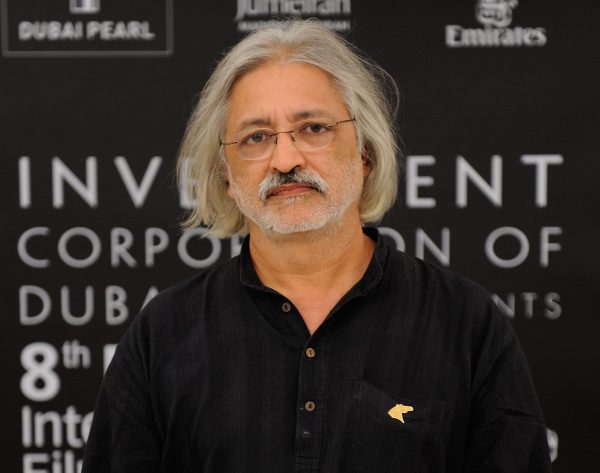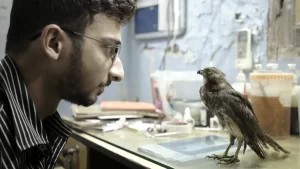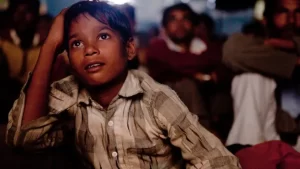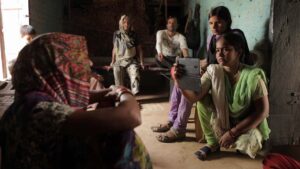6 Filmmakers Examine the Legacy of
Indian Documentary Trailblazer Anand Patwardhan
September 6, 2023
TIFF: As the beloved documentarian readies to premiere his latest at the fest, "The World Is Family,"
filmmakers like Shaunak Sen, Rintu Thomas, and Sushmit Ghosh expound on his legacy to IndieWire.

A new wave of Indian documentary makers have risen on the international scene in the last decade, exemplified by the Oscar-nominated titles “All That Breathes” and “Writing with Fire.” An important guiding light for this generation is the trailblazing filmmaker Anand Patwardhan and his rigorous socio-political films such as “Reason,” “Jai Bhim Comrade” and “War and Peace.”
Now, at age 73, Patwardhan is premiering his most personal film “The World Is Family,” profiling his own parents, at the 2023 Toronto International Film Festival. In celebration of this latest film and his rich career so far, we asked six filmmakers to describe what Patwardhan means to them.
Shaunak Sen (“All That Breathes”)

To hail Anand Patwardhan as a mainstay in the non-fiction constellation of Indian cinema has been something of an oft-trotted cliche, for at least three decades now. Yet there is a reason cliches are what they are: they represent a consensus so powerful that it takes on this form. Patwardhan continues to fuel the need to invoke his name as a mainstay because he is unyielding in continuing to make searing, clear-eyed politically important films.
My own relationship with his oeuvre has been somewhat complicated. Encountering his films in college, replete with all the brute force of their unwavering commitment to human-rights, I held that I “admired-more-than-loved” his filmmaking. At the time, I was more inclined towards a practice invested in questions of form, aesthetics, philosophy, and in conveying ideas through images that weren’t overtly explicit or prescriptive in their politics.
Consequently, (I am ashamed to say) rewatching certain Patwardhan films recently, I was struck by how much I had missed about their aesthetic and formal sophistication in my earlier viewings. The expressionistic grammar, the structural innovations, the often-playful sound design, the creative use of photographs and testimonials, and the sheer narrative nuance of films that are not afraid to be three or four hours long — there is cinematic joy to be had in rewatching and recognizing such details, details that were, for me at least, often eclipsed by the discussion of their turbulent subject matter.
If anything, it is clear that Patwardhan’s films have not been lauded enough for their formal/cinematic muscle. Each encounter with his films has left me increasingly in awe of his sheer filmmaking might. To double-down on the cliche, Patwardhan has indeed been a towering presence for almost three generations of Indian documentary filmmakers, for reasons of both form and content, and I for one am grateful for his body of work.
Vinay Shukla (“While We Watched,” “An Insignificant Man”)
I was 19 and in college when I first met Anand Patwardhan. Me and my friends were discovering the arts. It was a heady phase in our lives wherein you’d find new artists, share them, and be cool together. We would spend entire days culture-surfing on YouTube.
Then, one day, Anand Patwardhan came to my college with his film “War and Peace.” The film depicted the great nuclear race between India and Pakistan. I remember going for the screening casually with my friends, expecting very little from the film. But when the it ended, I was left with the yearning for a better world. I tried to shake off the feeling by cracking jokes with my friends. Anand then did a Q&A after the film wherein he treated us students like equals — asking us questions, challenging us, chiding us. I kept thinking about him and his film for months after that day. It’s like he knew how to throw the gauntlet out to his audiences.
I sought more of his films out and started watching them. With each film, I found characters who were exactly like my family members and my friends. His films were so deeply reflective of India that it felt like somebody had finally taken the most intuitive language there was and written searing poetry with it.
Shortly after college, I met new friends who, like myself, wanted to become filmmakers. One of our first (and almost qualifying) questions to each other would be, “What do you think of Anand Patwardhan’s films?” His body of work tethered the morality and aspirations of a generation of filmmakers. His films reflected India’s dreams and its various schisms. His politics was driven by empathy, his camera was always curious, and he was one of the rare filmmakers who were dedicated to the craft of cinema.
When I wrote my first short film, I reached out to Anand again because I admired him and wanted his opinion. Or, to be more honest, I wanted him to tell me that this is the best short film script he had ever heard. He invited me over to his house, heard me out, and then disappeared into his library without a word of praise. He came back with books from his shelf and recommended specific archives in Bombay that I should visit. I asked him what he thought of my script — he chuckled and said “Well, it needs more work.” Of course, it was a buzzkill. I absolutely hated him. I went ahead and made the short film I wanted to. It didn’t turn out great for a variety of reasons but I learnt something from Anand that day — when it comes to giving feedback to young authors, don’t bullshit them.
Over the course of my career, Anand Patwardhan has quietly helped me and several others like me. He’s passionate about docs. He has built communities around documentaries. You can find him at a film screening or at protest march. For my first film, he wrote emails to programmers to recommend my film and then followed it up with angry emails to the same programmers when they didn’t select it! On my new film, “While We Watched,” I am currently unable to find commercial distribution in India in spite of international success. Anand and his partner Seema came to know of this and here’s what they did — they booked an iconic theatre in Bombay, invited 300 people, hosted a screening of my film, were at the door to welcome audiences, introduced it, and absolutely front-lined the film.
Anand threw the gauntlet out to the audiences. How many maverick filmmakers do you know who would do that for a younger filmmaker? That’s how much passion Anand carries in his heart.
Shirley Abraham (“The Cinema Travellers”)

Nearly two decades ago, I got off that train to Bombay — the one that chugs the hopefuls into the arms and jaws of the megacity.
I had the gritty images of Anand Patwardhan’s “Bombay: Our City” in my mind’s eye. I was zero years old in filmmaking, but newly minted in hope. He was a bit of a hero. So when he agreed to meet, I carried along the one student documentary I had made, hoping it would act as my application to work with him. He watched it keenly.
“I’m not working on a new film at the moment.”
As my own little evangelist, I tried to say something about him being an inspiration and how much I longed to work with him. And, that I needed work as some kind of a life-raft in Bombay.
He offered me work on putting together director interviews for his DVDs.
“How much is your rent?”
“5,000.”
“I will pay you 10,000.”
I hold my first salary in Bombay as a little lesson that sticks to my ribs two decades later. To find ways to serve fairness in small gestures.
In the month after, I rode a bus to his home, gazed around at his marvellous and lively house, bursting with his work, and work to be. Accompanied him to screenings of his film; one time he timidly asked if he smells sweaty, he hadn’t been able to bathe yet after a round of exercise. We worked on editing his interviews. Ate from his lavish table, dotted with luscious chutneys, he urged me to try grapefruit.
Perhaps this is feeding into the mythology of the man. Sure enough, he is a man of material and social privilege. A privilege that could have been a blindspot, obscuring what’s beyond one’s field of vision.
On most days I see the mantle of justice as a burden, an uneasy one, on documentary. But in these desperate and terrifyingly factitious times in India — one that Anand’s epochal work has cautioned us against, I would like to echo John Berger and believe in art as some form of portable, representative justice. And salute Anand, the warrior for justice.
Chaitanya Tamhane (“The Disciple,” “Court”)
India hasn’t produced a more important documentary filmmaker than Anand Patwardhan. My debut feature “Court” owes a great debt to his landmark film, “Jai Bhim Comrade.”
His body of work spanning several decades, his truthful and relentless documentation of Indian society with all its flaws and complexities, has served as a constant source of inspiration and an artistic roadmap to not just me, but several generations of filmmakers and artists. His films are destined to become increasingly indispensable and invaluable in the times to come, as a mirror held to India’s past and present, reflecting on what we were, what we are, and what we may become.
Rintu Thomas and Sushmit Ghosh (“Writing with Fire”)

Anand Patwardhan to us, connotes continuum. When played in chronology, his films capture with perspicuity, the tumultuous journey of modern Indian history — with an underlying forewarning about an inexorable march towards the hollowing out of a democracy. And as filmmakers whose formative understanding of the non-fiction genre in India was through Patwardhan and his peers, it’s striking how his narrative style consistently calls attention to the very “act” of documenting. Creating itself as an act of enquiry and resistance.
From that moment in “Bombay, Our City” (1985), where a woman whose shanty-home has been demolished by the State chastises Anand for recording her misery on his camera to his last film “Reason/Vivek” (2018), where speakers at a press conference openly call for Patwardhan’s bones to be broken, while he is present in the room and identifies himself — Patwardhan’s camera is unafraid of asking tough questions and sitting in uncomfortable answers. As we continue to work in a country with under-nourished support systems for production and distribution of documentaries, Anand’s work stands tall as a symbol of defiance.
Recently, at a forum in Mumbai where our film “Writing with Fire” was being screened, Patwardhan was doing a talk. He shared anecdotes about the making of his short film, “Waves of Revolution” (1974), which is about student protests against the State’s mis-governance that eventually became a symbol of resistance to a dark period of India’s history, the Emergency. Anand edited and processed the negative prints in secrecy and then smuggled batches of final print of the film out of the country. It was pieced back together outside India and then found its way back through clandestine screenings across the country. His masterclass on documentary as a living piece of history, surviving through time and ingenuity.
He didn’t stop there. After the Emergency ended, he insisted that the film be screened on Doordarshan, the country’s singular state-sponsored channel. It is this dogged persistence to show his films to as wide and diverse audience as possible that defines the spirit of Patwardhan’s cinema. This characterises Patwardhan’s legacy.
Today, when critical thought is under the greatest threat, making films alongside Anand has been both inspiring and invigorating.
Thom Powers is the documentary programmer for the Toronto International Film Festival and co-founder of America’s largest documentary festival DOC NYC. He hosts the podcasts Pure Nonfiction for the TIFF podcast network and Documentary of the Week for New York’s public radio station WNYC.